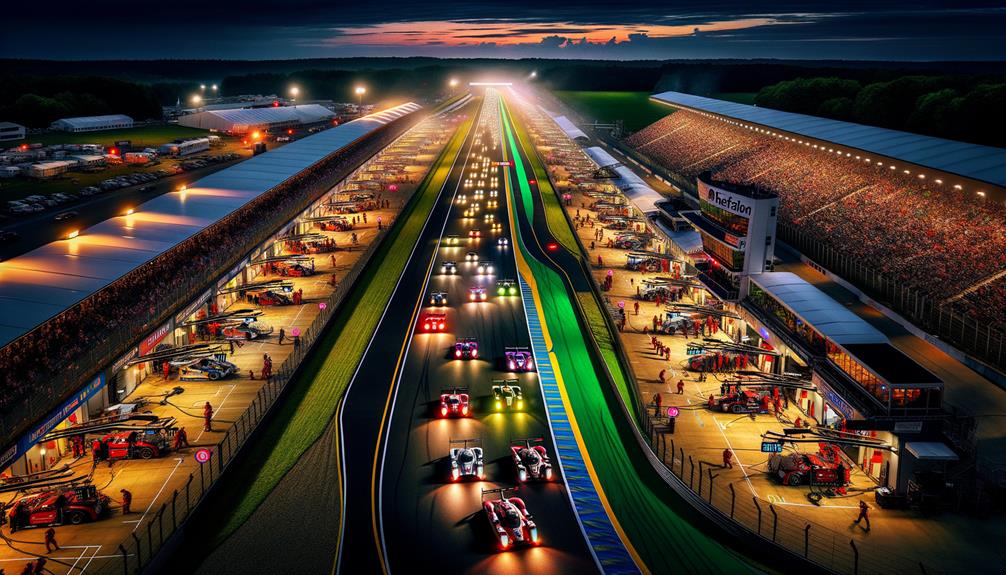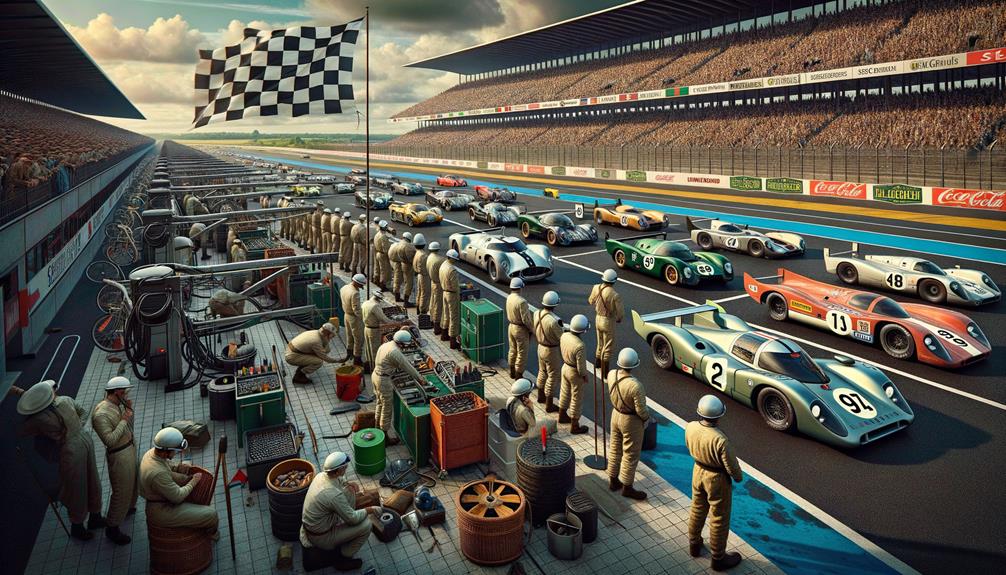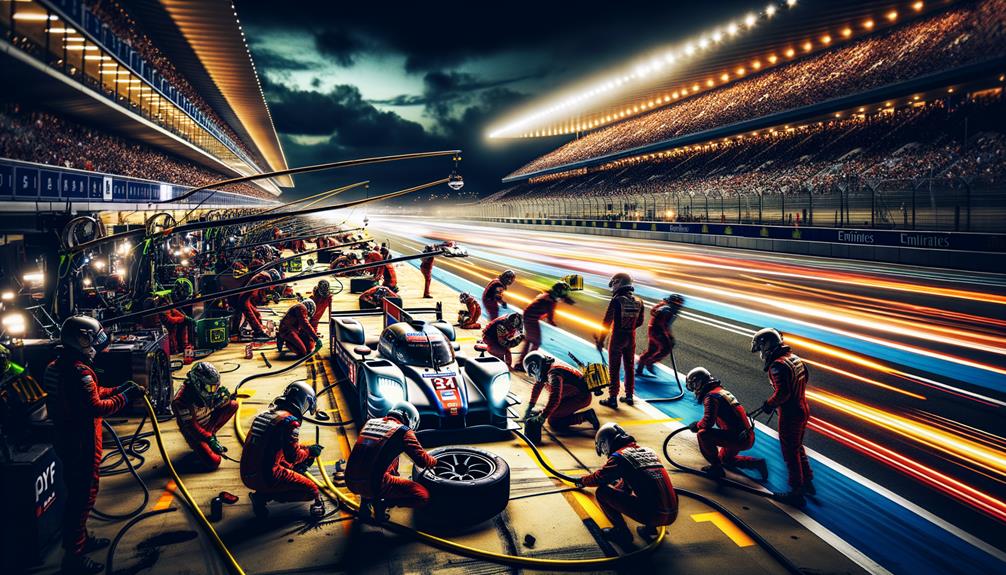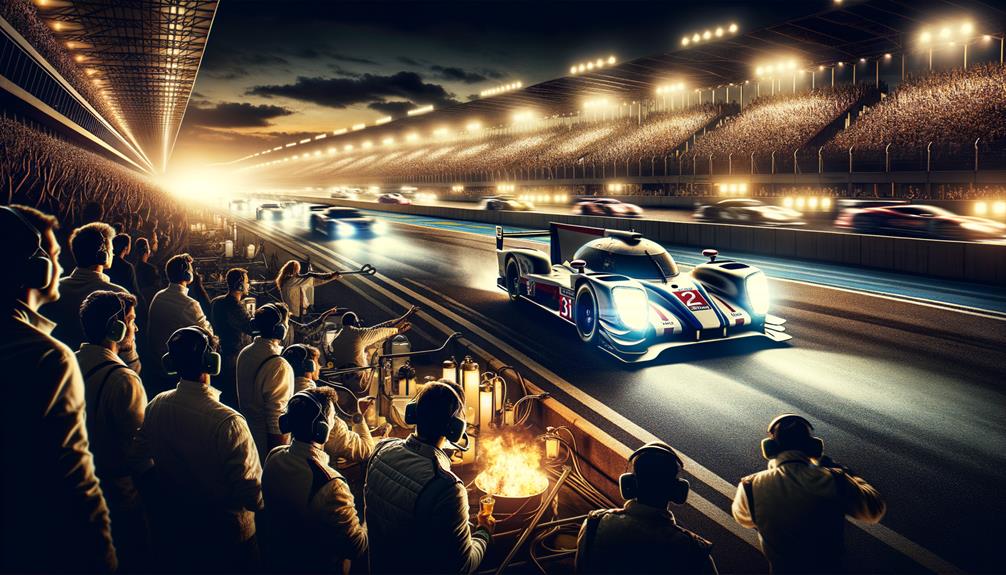Isn't there something captivating about watching cars race for 24 hours straight? The Le Mans 24 Hours Race, which has been around since 1923, isn't just any race; it's a tough test of both human and mechanical stamina. I'm always drawn to the blend of cutting-edge technology and the sheer determination of the drivers. As they tackle the challenging Circuit de la Sarthe, you have to wonder what keeps them going, lap after lap. What makes this event more than just a speed contest?
Event Overview
The 24 Hours of Le Mans is a legendary endurance race held every year near Le Mans, France, and has been testing drivers and their cars since 1923. Set on the famous Circuit de la Sarthe, this race pushes participants to cover over 5,000 kilometers in just one day. The demands are immense, not just on the drivers, but on the vehicles too. This race isn't just about speed; it's a true test of endurance and mechanical reliability.
The Circuit de la Sarthe combines public roads with dedicated racing tracks, creating a unique and challenging environment. Walking along the track, you can see tire marks and imagine the roar of engines during the race. The event features both prototypes and Grand Touring cars, showcasing the best in automotive innovation. The cars aren't just racing each other; they're battling the clock, the weather, and their own limits.
Organized by the Automobile Club de l'Ouest (ACO), the race emphasizes efficiency and reliability, encouraging manufacturers to develop cutting-edge technology for fuel efficiency and aerodynamics. It's a place where the spirit of freedom and innovation truly comes alive.
Recent Highlights

I was amazed to see Ferrari secure its second straight win at Le Mans this June, proving its strength in the Hypercar category. IDEC SPORT also impressed with a strong podium finish in LMP2, adding to the excitement and showing the determination of all the teams. The race was filled with new technology, pushing the limits of endurance racing and showing the drive for perfection.
Ferrari's Consecutive Victory
Ferrari's back-to-back win at the 24 Hours of Le Mans in June 2024 showcased the team's unmatched skill and strategy in this demanding endurance race. With engines roaring and tires gripping the historic track, Ferrari once again proved they are a powerhouse in motorsport. Watching them handle each corner and straightaway with such precision was like witnessing a symphony of speed and control.
The race was a testament not just to speed, but also to endurance and teamwork. Ferrari's pit crew operated seamlessly, executing perfect pit stops and tire changes that kept their cars in the lead. The drivers, combining skill and determination, maintained a relentless pace, pushing the limits of both man and machine.
Their consecutive victories have cemented Ferrari's status as a leader in endurance racing. It's not just about winning; it's about pushing boundaries and setting new standards. Ferrari's success at Le Mans highlights their unwavering commitment to innovation and excellence, reinforcing their storied legacy in motorsport. In a race where every second counts, Ferrari's mastery is truly inspiring.
IDEC SPORT's LMP2 Podium
While Ferrari's dominance grabbed headlines, IDEC SPORT Racing's impressive third-place finish in the LMP2 category at the 24 Hours of Le Mans deserves its own recognition. As the 2019 European Le Mans Series champion, IDEC SPORT Racing has consistently demonstrated their talent, but this podium finish at the prestigious Le Mans race truly showcases their endurance racing skills.
Watching IDEC SPORT Racing tackle the grueling 24-hour marathon was thrilling. The team's precision and competitive spirit were clear with every lap. Their expert car handling, strategic pit stops, and sheer determination led to a well-earned third place in the LMP2 category.
The 92nd edition of the 24 Hours of Le Mans was especially tough, with unpredictable weather and intense competition. Yet, IDEC SPORT Racing's consistency and resilience stood out, highlighting their strong presence in endurance racing. Their performance at Le Mans wasn't just about speed; it was a blend of strategy, stamina, and skill.
IDEC SPORT Racing's podium finish is a proud moment, reflecting their unwavering commitment to excellence. It's a testament to why they're a formidable force in the world of endurance racing.
Technological Innovations Showcased
In the midst of roaring engines and fierce competition, the Le Mans 24 Hours race stands out as a testing ground for cutting-edge automotive technology. As I stroll through the paddocks, I'm struck by the advanced hybrid systems in the LMP category, where flywheel, super-capacitor, and battery technologies come together seamlessly. These innovations aren't just for show; they're setting new standards in endurance racing.
Fuel economy has been a key focus since the 1970s oil crisis, and it continues to drive progress. Manufacturers are producing faster, more efficient, and reliable road cars, and this technology trickles down to the GT cars on the track. These machines are not only quick but also embody the balance that Le Mans demands.
The race is more than just a competition; it's a display of state-of-the-art technology and engineering solutions. Each year, the limits of speed, efficiency, and reliability are pushed further, setting new benchmarks. Watching the race, I can't help but feel excited, knowing these innovations will soon make our everyday cars safer, greener, and faster.
Historical Context

When I think about the Le Mans 24 Hours Race, I imagine its modest start in 1923, a time when cars were tested for more than just speed but for endurance as well. Over the years, the race has grown, marking milestones like the introduction of new technologies that pushed automotive engineering forward. This event has become a celebration of the development of endurance racing, with each era bringing its own set of challenges and successes.
Early Race Origins
The Le Mans 24 Hours race, which kicked off in 1923, is all about pushing cars to their limits in terms of endurance and innovation. This race isn't just about going fast; it's about seeing how well cars can perform over a whole day. Held near the charming town of Le Mans, France, the event has become the gold standard in endurance racing.
In its early days, the focus of Le Mans was on building cars that were not only speedy but also reliable and efficient. Car makers from all over the world were invited to create vehicles that could handle long hours of driving, sparking significant advancements in automotive technology. This emphasis on aerodynamics, fuel efficiency, and durability laid the groundwork for today's car industry.
The race, held every year in mid-June, quickly drew top manufacturers and teams, all eager to showcase their engineering skills. The start of the race in 1923 marked a new era where endurance, rather than just speed, became a key factor in automotive development, establishing Le Mans as the ultimate endurance racing event.
Evolution Over Decades
Over the years, Le Mans has grown from a local endurance race into a worldwide event, showcasing the evolution of automotive technology and racing strategies. Looking back from its start in 1923 to its inclusion in the FIA World Endurance Championship in 2012, you can see a history rich with innovation and determination.
Le Mans isn't just another race; it's a proving ground where car makers push the limits of what's possible. The changes over time are clear:
- Technology: From basic engineering to advanced hybrids, Le Mans has always highlighted the latest in automotive tech.
- Race Strategy: Teams have moved beyond focusing solely on speed. Now, endurance, aerodynamics, and reliability are key, recognizing that a well-paced race often beats pure speed.
- International Appeal: Once a French event, it's now a global attraction, drawing teams and fans from all over the world and cementing its place in the Triple Crown of Motorsport.
- Consumer Impact: Innovations seen at Le Mans often make their way into everyday cars, improving safety and efficiency for everyone.
In short, the Le Mans 24 Hours race shows how far we've come in endurance racing and hints at where we're going next.
Notable Milestones Achieved
Few races have the historical weight and technological milestones that the 24 Hours of Le Mans carries. Since its start in 1923, the race has evolved from an endurance test to a showcase of cutting-edge automotive technology. Teams like IDEC SPORT Racing embody this spirit, continually pushing boundaries in the 24-hour challenge.
In the 1950s, the race became part of the World Sportscar Championship, setting a new standard for endurance racing. Icons like A.J. Foyt and Tazio Nuvolari made their mark, with their victories becoming legendary. When the FIA World Endurance Championship took on Le Mans in 2012, it reaffirmed the race's global importance.
Le Mans is where automotive giants test their latest innovations. From disc brakes to hybrid technology, the race has been a proving ground for performance and reliability. Each year, it's not just a race but a testament to human ingenuity and resilience. The 24 Hours of Le Mans remains a gripping story of speed, endurance, and technological breakthroughs.
Race Circuit

Each year, drivers tackle the tough challenge of mastering the roughly 8.5-mile Sarthe road-racing circuit near Le Mans, France. This track isn't just about speed; it's a brutal test of endurance, strategy, and skill. Each lap demands a mix of precision and raw power, pushing both drivers and their cars to the edge.
When you think of Le Mans, a few standout features of the circuit come to mind:
- Mulsanne Straight: This famous stretch lets cars hit incredible speeds, pushing their top-end performance and stability to the max.
- Tertre Rouge: A tricky corner that needs exact accuracy, setting the stage for the high-speed sections ahead.
- Porsche Curves: A series of tough bends where drivers must skillfully manage their speed and grip.
- Arnage Corner: Known for its sharp turn, it's often where races are won or lost, requiring perfect braking and acceleration.
Le Mans has a storied history filled with epic moments and fierce battles, making it a favorite among racing fans. The track's demanding nature rewards those who conquer it, offering an unforgettable experience for anyone brave enough to take on the challenge.
Technological Innovations

As drivers tackle the challenging Sarthe circuit, they rely heavily on cutting-edge technology to gain an edge in the grueling 24-hour race. At Le Mans, endurance racing teams use hybrid systems like flywheels, super-capacitors, and batteries to enhance both performance and efficiency. These advancements aren't just about speed; they also focus on fuel economy, a priority since the 1970s oil crisis.
I've seen how manufacturers at Le Mans strike a balance between speed, efficiency, and reliability. It's fascinating to watch these innovations, born from the high-pressure environment of endurance racing, make their way into the consumer market. The same technologies that power these powerful machines are shaping the development of faster, more efficient GT cars.
Fuel economy is always a top concern, with teams constantly pushing the boundaries of what's mechanically possible. This pursuit of efficiency doesn't just win races; it influences the evolution of everyday road cars. Le Mans is a testing ground for the engineering solutions that shape the future of automotive technology, making each car not just faster, but smarter and more efficient.
Regulations and Traditions

Le Mans 24 Hours isn't just about speed and endurance; it's a race deeply rooted in strict rules and rich traditions that define its legendary spirit. The regulations for this 24-hour endurance event are crucial for ensuring fairness and safety for everyone involved. Here are a few interesting rules and customs:
- Driver changes and seating: Every car must have space for a second seat, making driver changes smoother and ensuring driver safety.
- Safety enhancements: Since 2014, LMP1 cars are required to have a roof, offering better protection for drivers in case of an accident.
- Garage 56: This special area is set aside for testing new technology and experimental innovations, highlighting the future of motorsport.
- Driving and maintenance rules: Drivers must follow strict maximum drive times, and there are specific guidelines for refueling and maintenance to keep the race fair and safe.
Experiencing these regulations firsthand, I've felt the meticulous planning and tradition that give Le Mans its unique character. It's not just a race; it's a celebration of human ingenuity, resilience, and the relentless drive for progress.
Teamwork Dynamics

In the high-stakes world of the Le Mans 24 Hours race, teamwork is the key to success. The grueling nature of this race demands a unified team effort where everyone, from drivers to mechanics, plays a crucial role in aiming for victory. Long before the race day, teams are busy with simulated racing scenarios to perfect their teamwork. This preparation ensures everyone knows their responsibilities and can perform under pressure.
The race itself is a testament to collaboration. Drivers switch shifts, mechanics handle quick repairs, and the crew constantly strategizes. It's not just about the drivers; the entire team must work in harmony to cover the extensive distance and tackle any unexpected challenges that arise.
Here's a quick look at the essential roles:
| Team Member | Role |
|---|---|
| Drivers | Maintain race pace, adapt to conditions |
| Mechanics | Perform repairs, manage car health |
| Crew Chief | Strategy planning, decision making |
| Support Staff | Provide logistics, nutrition, and morale support |
The magic of Le Mans lies in this cohesive team effort. It's a blend of skill, precision, and relentless determination, where every part must work perfectly together.
Distance Covered

Thinking about the Le Mans 24-hour race, the distance covered is mind-blowing—teams often go beyond 5,000 kilometers. Handling this tough race means carefully planning driver changes and timing pit stops just right to keep an average speed of 207 km/h. It's not just about speed; it's about balancing endurance, precision, and teamwork flawlessly.
Total Kilometers Covered
Racing teams in the Le Mans 24 Hours event cover an incredible distance, usually around 4,968 kilometers over the intense 24-hour period. It's a figure that truly captures the essence of endurance racing. Watching these cars zoom by at an average speed of 207 kilometers per hour, I can't help but feel a rush of excitement.
The Le Mans circuit tests both the reliability of the cars and the stamina of the drivers. Here are some interesting details:
- Distance: Teams often exceed 5,000 kilometers, pushing the limits of both the cars and the drivers.
- Speed: Keeping an average speed of 207 km/h, even with pit stops, is quite a challenge.
- Teamwork: Several drivers share the driving duties, which underscores the importance of working together.
- Strategy: Careful planning and performance tuning are crucial for making it through this relentless race.
Watching the Le Mans 24 Hours race is like seeing a blend of precision and endurance. Each team navigates the track's curves and straights with intense focus. The distance covered isn't just about the kilometers; it's a testament to the spirit of freedom and the pursuit of what's possible in racing.
Driver Shifts Strategy
Every team carefully plans driver shifts to ensure they stay at their best and cover the grueling 5,000 kilometers efficiently. In the Le Mans 24-hour race, driver shifts are not just about necessity; they're a strategic art. Each driver usually takes the wheel for 3-4 hours, making sure they're rested and ready to keep up the relentless pace demanded by this legendary event.
The strategy behind these shifts is intriguing. It's about balancing driver fatigue while maintaining fast lap times. Teams aim for smooth transitions to minimize time lost during pit stops. Here's a look at a typical shift strategy:
| Driver | Shift Duration | Distance Covered |
|---|---|---|
| Driver A | 3 hours | 625 km |
| Driver B | 3.5 hours | 730 km |
| Driver C | 4 hours | 840 km |
| Driver A | 3.5 hours | 730 km |
| Driver B | 4 hours | 840 km |
Driver stamina and focus are crucial, especially on the challenging Circuit de la Sarthe. Each shift feels like a battle, not just against other teams, but against the physical and mental limits of endurance. This well-coordinated dance of driver shifts is what makes the Le Mans 24-hour race a true test of human and machine working together.
Pit Stops Frequency
Managing pit stops is crucial in navigating the 5,000 kilometers of the Le Mans 24-hour race. Teams usually make around 30 pit stops throughout the race, each one carefully planned to fit into their overall strategy. The efficiency of these stops can significantly impact a team's performance, lasting anywhere from 30 seconds to a minute, depending on the required services.
Pit stops are critical for:
- Fuel Refills: Making sure the car has enough fuel for the next segment.
- Tire Changes: Replacing worn tires to keep optimal grip and performance.
- Driver Swaps: Allowing drivers to rest so they can perform at their best.
- Minor Repairs: Fixing any small mechanical issues that might affect the car's efficiency.
The number of pit stops varies based on car efficiency, tire wear, and driver stamina. Balancing these factors is key to staying competitive. Watching how teams handle these elements reveals the complex strategy and precision that define the Le Mans race.
Key Circuit Challenges

Tackling the high-speed straights and technical corners at Circuit de la Sarthe requires a mix of precision, skill, and unwavering focus. The 24 Hours of Le Mans pushes every driver to their limit, especially on the legendary Mulsanne Straight, where speeds can reach up to 405 km/h. Handling this stretch demands not just raw speed but also careful braking and steering, particularly as it transitions into the tricky Porsche curves and Ford chicanes.
The Circuit de la Sarthe combines public roads with a dedicated track, making it a unique challenge. Drivers are at full throttle for about 85% of the circuit, constantly seeking the perfect racing line. Each section tests both mental and physical endurance, pushing drivers to their breaking point.
Here's a breakdown of some key sections:
| Section | Characteristics | Challenges |
|---|---|---|
| Mulsanne Straight | Long, high-speed straight | Maintaining control at top speeds |
| Porsche Curves | Series of fast, sweeping corners | Precision braking and handling |
| Ford Chicanes | Tight, technical corners | Maneuvering without losing too much speed |
Every turn and straightaway at Circuit de la Sarthe demands respect, making the 24 Hours of Le Mans a true test of a driver's skill and endurance.
Notable Honorees

In the world of motorsport, few names stand out at the 24 Hours of Le Mans quite like A.J. Foyt, Phil Hill, Tazio Nuvolari, and Graham Hill. These racing legends have made unforgettable contributions to this iconic endurance race, earning their places in motorsport history.
- A.J. Foyt – An American icon, Foyt's 1967 win with Dan Gurney in a Ford GT40 is legendary. Their victory showcased sheer talent and unwavering determination.
- Phil Hill – As the first American to win Le Mans in 1958, Hill's driving skills combined precision with daring, making him a standout.
- Tazio Nuvolari – Known as the 'Flying Mantuan,' Nuvolari's 1933 triumph is celebrated for his incredible skill and fearless approach to racing.
- Graham Hill – By winning Le Mans in 1972, Graham Hill completed the rare Triple Crown of Motorsport, a remarkable achievement that few have matched.
These drivers' feats at Le Mans have cemented their legacies, symbolizing excellence and success. They continue to inspire and influence future generations, embodying the spirit of endurance and passion that defines the 24 Hours of Le Mans.
Frequently Asked Questions
How Many Miles Is 24 Hours at Le Mans?
I was amazed at the distance covered in just 24 hours—about 3,085 miles. Watching those sleek cars speed down the track gave me a sense of freedom, knowing they were pushing the limits of speed and endurance.
Do They Still Race 24 Hours at Le Mans?
Yes, they still race for 24 hours. I've been there myself, feeling the engines' roar and watching the pit crews work like a well-oiled machine. It's a thrilling test of endurance and innovation that engages all your senses.
Do Drivers Drive for 24 Hours Straight at Le Mans?
You think drivers stay behind the wheel for 24 hours straight? That's a nice thought, but they actually take shifts. Typically, they drive for 2-3 hours before swapping out. It's all about strategy, rest, and keeping performance high throughout the race.
What Are the Rules for the 24-Hour Le Mans?
The rules for the 24-Hour Le Mans cover everything from car design to driver shifts. Cars must have two seats and a roof. There's also a limit on how long each driver can race. Refueling and maintenance follow strict guidelines to ensure safety and fairness throughout the event.



